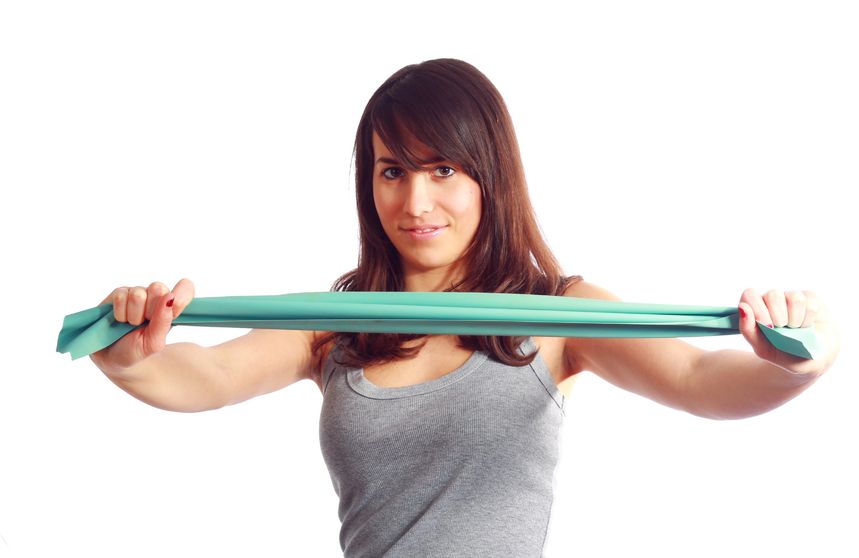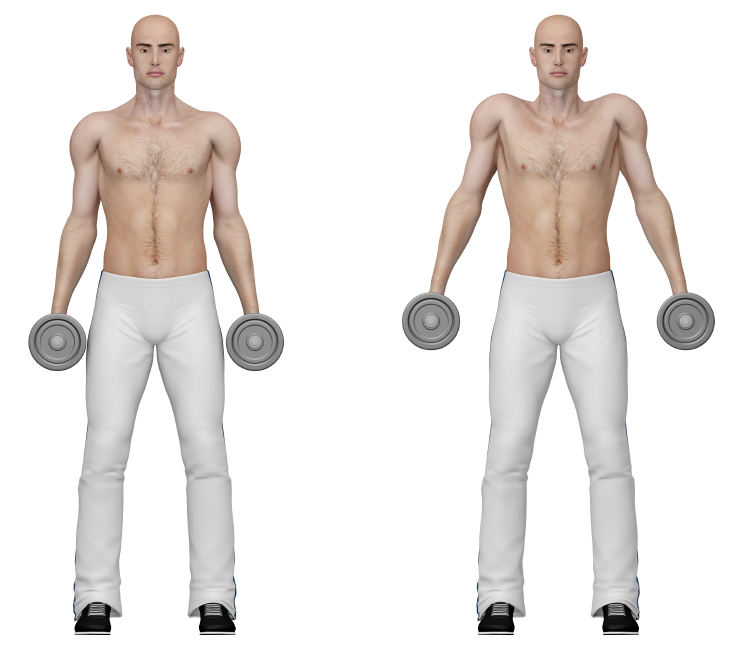Cervical Spine Exercises for the Neck and Shoulders

Tid Bits of Info
- Cervical spine posture is dependent on strength, endurance and flexibility of the neck and shoulders.
- Perform these exercises daily.
- Pain in the neck can originate from the muscles or joints. If you have referred pain into your arms seek medical advice immediately.
- Your Physical Therapist can design an exercise program for you.
- Ask your Physical Therapist to assess your posture and over-all condition if you are hoping to avoid the onset of symptoms or if you are currently experiencing them.
This post is part of our Exercise Essentials Series introducing specific exercises that can be and should be performed by everyone to help maintain the proper flexibility, strength and muscular endurance of a particular body part. A habit of regular training can help reduce injuries and improve overall conditioning.
Flexibility is needed in all soft tissues to guarantee proper motion of the joints. Without proper motion, there can be excess stress and strain applied to an area and cause an injury or pain.
There are numerous exercises to maintain the health of our body and some require the use of weights, machines, resistance tubing, medicine balls, theraballs and many other ways to add resistance to the exercise. Your Physical Therapist can assist you in designing a proper exercise routine for your specific condition.
Maintaining Posture Through Cervical Spine Exercises
A regular routine of exercises for the cervical spine can help reduce pain and increase strength, range of motion and mobility of your neck. Training helps to maintain the proper posture of the cervical spine, which is a reversed “C” form.
The human neck is made up of 7 cervical vertebrae. The bones are designed to provide a lot of motion in many planes of motion and are the resting place for the skull. The human head weighs between 10-15 pounds and must be supported and moved by the cervical paraspinal muscles and other muscles that are more superficial. If this is lost due to injury, laziness, environment, or any other reason, the muscles of that are responsible for the movement and support can be damaged. This damage can cause pain that might lead to decreased motion and strength. The function of the cervical spine can be jeopardized if this damage is severe enough.
The following exercises will ensure that your cervical spine remains in good condition. Unfortunately, your neck might get injured for reasons that are out of your control. If you sustain neck pain and it does not respond to your “home remedies” within a short period of time (1-3 days) seek help with the problem from your Physical Therapist.
Developing a Cervical Spine Exercise Routine
There are two types of exercises introduced below: strength/muscular endurance exercises and stretching exercises.
Strength exercises will require that you apply an “over-load” resistance to the muscle group during the exercise routine. This can be in any form. The more resistance applied, the more the muscle must “work” to develop the strength to “handle” that resistance. These exercises should be performed in sets of 5-7 repetitions and 5-10 sets per day. These muscles and all muscles should never be “strength” trained on two consecutive days.
Endurance training is very similar to strength training in that the exact same exercises are used for both. Endurance training uses a higher number of repetitions and less weight/resistance. These exercises are performed in sets of 12-20 repetitions. 3-5 sets are usually sufficient to get the desired result in the muscle. In strength training and endurance training it is essential that proper form of the exercise is used for every repetition of the exercise. If the form is bad, an injury can occur. If you need assistance in developing proper form seek help from your Physical Therapist.
Stretching exercises increase flexibility. Flexibility of the cervical spine can be compromised if there is an injury or improper posture is assumed for a prolonged time. Each joint must be able to move freely or it can cause the other joints to move improperly and cause pain or decreased motion.
When trying to achieve the goal of increasing the flexibility of a joint one must be able to “stretch” the elastic and non-elastic materials that hold the joint together. The elastic materials are primarily the muscle tissue. Similar to a rubber band the muscle can be stretched and it will “snap” back and return to the original length. Slight increases in this length can be achieved if prolonged, frequent stretching is performed.
The best way to “gain” flexibility is to elongate the non-elastic materials. These structures are designed to provide intrinsic stability to the joint and react similarly to leather. Prolonged, frequent stretching can increase the pliability and length of these structures. “True” increases in flexibility require these structures to elongate. Stretching exercises should be performed daily and several times per day.
The stretch should be slow, methodical and held at a place in the motion when the structures that are stretched produce a slight amount of discomfort and pain. If these exercises are performed to aggressively further injury can occur and if done too passively no change in elongation will take place. It would be better to perform 1000 proper stretches per day that cause a slight amount of pain than 10 aggressive stretches that produce a severe amount of pain.
Your Physical Therapist can teach how to stretch properly and they can perform specific manual techniques will enhance the flexibility of the individual joints of the spine. Some of the techniques used by Physical Therapists might be painful when they are performed, but the pain will subside shortly after they have completed the treatment session.
Cervical Spine Exercises
SHRUGS: Stand facing a mirror to assess your posture and be able to watch your shoulders move symmetrically. Hold weight in your hands and keep your arms at your side. Your elbows remain straight throughout the lifting motion. Start by moving your shoulders upwards towards your ears. At the top of the motion pause, and then move your shoulders backwards.
This is the most important aspect of this exercise. As your shoulders move backwards you should think that you are trying to put your shoulder blades (scapulae) together. The muscles that “pull” the shoulder blades together are essential in maintaining proper posture of the shoulders and cervical spine. When the shoulders have traversed the entire way backwards, pause and squeeze the shoulder blades together and then lower your shoulders to the starting position.
LATERAL RAISES: Stand facing the mirror. Watch your shoulder motion and be sure that it remains symmetrical throughout the exercise. While you hold the weights in your hands, your elbows are bent to a 90 degree angle. Without straightening your elbows, begin to raise your elbows up to shoulder level, keeping your elbows bent and hands facing downward. Your motion should stop when your elbows are at shoulder level (remaining at a 90 degree angle) and your forearm is parallel to the floor. Many people attempt to lift too much weight and cannot maintain symmetrical motion or be able to control the weight when it is at its highest point. Excessive “hiking” of one of your shoulders could indicate a weakness or lack of motion in that joint. This type of compensation motion can place a tremendous excess strain on your cervical spine and cause it to hurt.
NECK EXTENSION: Lie prone (face down) on a bench or bed, with your head hanging over the edge. Keep your arms, chest and lower extremities flat on the bench. Begin the exercise by raising your head, as if you are trying to look upwards, and continue to raise your head until your chin is parallel to the floor and you can look directly in front of your workout station. Raise your head, but keep your chest flat on the table or bed. You should not experience pain or tingling in your Upper Extremities as you raise your head. . If you have been diagnosed with Cervical Spine arthritis, you may not be able to perform this exercise.
NECK ROTATIONS: This exercise partners well with the Neck Extension exercise. This exercise has two parts to it, but can be performed in the same position and at the same time. You can continue to perform this routine after your finish the desired repetitions of the Neck Extension exercise. The first part of this exercise begins with the head hanging over the edge of the bench or bed and the arms, chest and lower extremities are flat on the bench or bed. Begin the exercise by rotating your chin towards either shoulder. Do not raise your head from the starting position. Repeat this motion to the opposite side for the desired number of repetitions.
The second part of this exercise consists of the Neck Extension exercise and a rotation. Begin by raising your head to a fully extended position, as if you are trying to look upwards, so the chin is parallel to the floor. At the top of the motion, rotate your head towards one shoulder. The goal is to rotate far enough so that your chin is in line with your shoulder. Similarly to the Neck Extension exercise, if you experience pain or tingling in your upper extremities you should stop the exercise immediately. If you feel “lite” headed stop the exercise immediately!
PULL APARTS: Stand and hold a piece of Theratubing (Rubber tubing can be purchased at most sporting goods stores or ask your Physical Therapist for a piece) of appropriate tensile strength in your hands. Your arms should be at or near shoulder level and your elbows should be fully extended (straight). Your palms should be facing each other so that your thumbs are pointed towards the ceiling. Slowly move your arms apart and stretch/”pull apart” the Theraband. Your goal is to get your hands spread apart with your elbows straight and in line with your shoulders. Your arms should remain parallel to the floor at all times. The final phase of this exercise is to take your shoulder blades and squeeze them together. As the Theraband “recoils” your arms should move slowly back to the starting position.
 LATERAL STRETCHING: Standing or sitting, place one arm behind you, in the “small” of your back. Take the opposite hand and place it on top of your head, and slowly pull your head down moving that ear towards your shoulder. Pull until you feel a “stretch” discomfort in your neck on the opposite side. Hold that position for 15 – 30 seconds. Don’t pull too hard to cause sharp pain. Too much pain can cause the body to go into a “defense” mode and try to “protect” the area. This reaction can make it almost impossible to stretch that area. Too aggressive of a stretch could cause damage to the muscle tissue.
LATERAL STRETCHING: Standing or sitting, place one arm behind you, in the “small” of your back. Take the opposite hand and place it on top of your head, and slowly pull your head down moving that ear towards your shoulder. Pull until you feel a “stretch” discomfort in your neck on the opposite side. Hold that position for 15 – 30 seconds. Don’t pull too hard to cause sharp pain. Too much pain can cause the body to go into a “defense” mode and try to “protect” the area. This reaction can make it almost impossible to stretch that area. Too aggressive of a stretch could cause damage to the muscle tissue.
FORWARD FLEXION: Standing or sitting, place one arm behind you, in the “small” of your back. Take the opposite hand and place it on top of your head. Slowly pull your head and chin downwards, towards the center line of your chest (Sternum). Stay in that position for 15-30 seconds. Repeat this movement but change the direction of pull so that your chin is directed towards your breast or armpit. In both positions, pull until you feel a “stretch” discomfort in your neck on the side of the arm behind your back. Hold that position for 15 – 30 seconds. Don’t pull too hard to cause sharp pain. Too much pain can cause the body to go into a “defense” mode and try to “protect” the area. This reaction can make it almost impossible to stretch that area. Too aggressive of a stretch could cause damage to the muscle tissue.
CHIN RETRACTIONS: While sitting in proper posture, envision that you have a string attached to the back and top your head. The movement of this stretch is a slow movement of your chin backwards (not downward towards the Sternum). Envision that someone is pulling upwards on the imaginary string and your chin is being moved back to the top of your spine. The stretch should be felt at the very top of your spine and where the muscles attach to the skull. This stretch is designed to stretch the very top of the Cervical spine because too many people sit for prolonged periods time in a “forward head / rounded shoulder” posture. If the chin is moved downward and not backwards, the stretch does not isolate on this aspect of the spine.
There are thousands of cervical spine exercises that can be used for stretching and strengthening. The above are some suggestions that can be used by anyone. If you have questions about technique or alternate exercises, seek advice from your Physical Therapist. Physical Therapists are trained to educate patients on proper form and techniques that will help to alleviate your symptoms or prevent them from occurring in the first place. Your Physical Therapist can prescribe an exercise program that is specific for your condition.


























I need help as I have acute pain in neck,shoulder region (had c6-7 surgery too five years back)and also have a frozen left shoulder since August last year.
I need help as I have acute pain in neck,shoulder region and also have a frozen left shoulder since August last year.